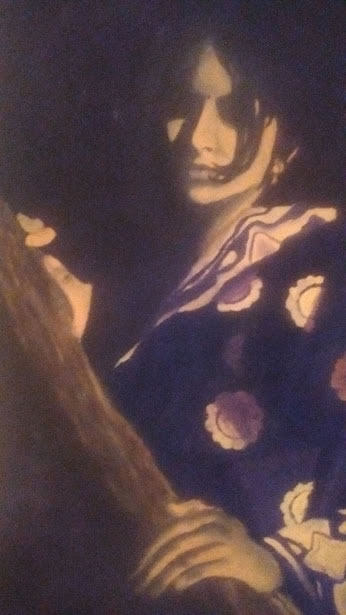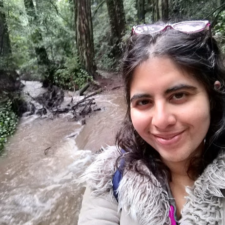I was driven by the forces that create and break language: sound, migration, immigration, alienation, speech, accent, imperialism, place, longing, myth, consciousness, archetype, universality, magic.” – Shilpa Kamat, “Saraswati Takes Back the Alphabet”
Poet, visual artist, and educator Shilpa Kamat contends with the violent legacies of imperialism, her lived experience, language, and threats of erasure in her chapbook, “Saraswati Takes Back the Alphabet,” finalist for the 2018 Anzaldúa Poetry Prize. In “eleven,” mid-way through the chapbook, Kamat writes, “the demons were never/ evil just regular/ people who prayed.”
The content of Kamat’s life—the experience of thinking across multiple languages, and being rooted in a particular lineage, Konkani, while having grown up elsewhere—is woven into the chapbook. She is concerned with nuance and layers, integrating her fascinations with magic and the sociopolitical without oversimplifying the past. Kamat is committed to exploring where magic still resides despite every violent attempt to erase it.
In the chapbook’s title poem, Kamat writes: “when she is done/ everyone/ uses plural in the singular/ stuffs their heartbeat/ into the first pocket”
Patrycja Humienik: When did you begin writing “Saraswati Takes Back the Alphabet?” Is there an image, idea, feeling that initiated the project?
Shilpa Kamat: Many, perhaps all, of these poems were written in an effort to transmute pain while at the same time, creating space for the experiences that often slip through the cracks of (personal, global) history. I was driven by the forces that create and break language: sound, migration, immigration, alienation, speech, accent, imperialism, place, longing, myth, consciousness, archetype, universality, magic.
The “speech migration” poems emerged while I was writing in an old growth redwood forest a few years ago. My experience of my voice, of how I lost access to it in my childhood, emerged as I wrote. I should note that I am a highly emergent writer. The content of my life springs up.
The poems that span some of the history of my lineage (as well as my interactions with other histories) began in response to a painful discussion. I found myself exploring cultural pain, ranging from misunderstandings or micro-aggressions to outright oppression and cultural/linguistic erasure. I am rooted in a specific lineage, but I grew up in multiple places, and the histories of those places also inform my experience.
Many of the Konkani and “Konglish” poems that I included in this manuscript are some combination of surreal and lyrical. I wasn’t sure what to do with them when I wrote them since the market for experimental Konkani poetry seems nonexistent. When I was pulling together this chapbook, I saw that there was finally a place for them to “fit.”

Humienik: Your manuscript generously provides snippets of Konkani history. Is poetry a way you stay connected to that history and lineage? Is poetry a part of your family history?
Kamat: I love the connective potential of poetry for many reasons, including the potential for exploring my linguistic and historical roots while remaining present.
As a toddler, I spoke fluent Konkani in each of my parents’ dialects. My experiences in school led to the silencing of my Konkani for many years. Although my parents never stopped speaking Konkani at home, I didn’t speak back to them in Konkani again until adulthood.
Now, my accent is somewhat Americanized, and I generally only feel comfortable conversing with my family members or with children—but I still think in multiple languages, and the connotations of Konkani words and phrases inform my daily existence. Even during the long period of silence that I mentioned, I explored writing and performing contemporary poetry in Konkani.
I want to keep my language alive in my world as well as to claim my own expression of it, which may differ from expressions in other regions. I resent the ways in which the beasts of monolingualism erase diversity and stifle creative potential. I want something better for the planet than the cultural/linguistic extinctions that we are facing (along with plant/species extinction). Poems and songs help.
Humienik: You contend with a large swatch of justice issues in the chapbook. You also named, as one of those many “forces that create and break language,” universality, myth, consciousness, and magic, indicating this as a place you naturally go. Can you say more about this fascination, and how you see these forces—magic and the sociopolitical—as connected?
Kamat: The sociopolitical intersects with magic only in the places where it doesn’t seek to constrain, to rigidly define, to contain within linear boundaries. Whenever people’s interpretations of language, of the world, grow too literal, the potential for magic fizzles. Fundamentalist attitudes neutralize this potential. Even radical/intersectional theories, for all their scope and idealism, can lose magic when their interpretations are overly rigid/polarizing. When trying to access the parts of the consciousness in which the potential for magic resides, nuance is essential.
There is magic in the social, in the natural—and when I say “natural,” I include the bodies and psyches of human beings. There is magic in the wisdom and worldviews of indigenous communities that forces seeking to dominate or colonize often strip away.
In navigating my work, I am aware of the play between Western philosophies that elevate diversity and Eastern philosophies that elevate oneness/union. There are stories of shapeshifters, of rebirth, in which superficial aspects of identity are revealed as ephemeral rather than essential. There are stories in which ancestry, profession, migration histories, etc. are vital. Frequently, those mired in a single orientation will condemn the other as “wrong”; I prefer to wrestle my way to the best of both.
Earlier, I described how the majority of poems in “Saraswati Takes Back the Alphabet” explore and transmute pain. I would say that there is a magic in moving through and beyond the pain of history, in inviting unheard or silenced narratives to express themselves, in creating new narratives or assembling bridges between narratives—however we can lead ourselves to wholeness, balance, renewal.
I wanted to break language so that fluent readers of English would experience the dissonance that those struggling to break into the language might experience.” – Shilpa Kamat
Humienik: I was drawn to the play with organic form in your chapbook—the way you use space between and within lines and also between letters. Do you remember when you began to play more with form in your work? Has form always been a fascination for you as a poet?
Kamat: I am a visual artist as well as a poet, so yes, I am as fascinated by the form of my words (and the ways in which their placement may inform readers) as I am by their sounds. Both image and sound can inform meaning, and I strive to understand and stretch these elements within the constraints of typed language.
When working with pulling sounds apart in “anoutofcontrolsilence” (from which I pulled the “speech migration” poems), I wanted to break language so that fluent readers of English would experience the dissonance that those struggling to break into the language might experience. I wanted readers to slow down, to pull together sounds in the way we all had to when we were first beginning to read. Speech precedes sound; by decomposing speech, I wanted to parallel the breaking of the world as old growth languages and forests alike are threatened. The form of each poem reflects my experience: its density, or its meandering, the way it breaks off. The content extends to contain collective experience as well.
My more “historical” poems explore form in other ways, such as the “glitter” poems (“It Became Theirs!” and its Konkani equivalent). I wanted the scope of these experiences or histories to sprawl across the page while also being contained by the page.
Humienik: Do you find your visual art converging with poetry, or are those creative practices distinct for you?
Kamat: I often engage in interdisciplinary art, whether I am incorporating dance and/or visual art into a literary performance, illustrating my writing, or incorporating the written word into visual art pieces. There are specific questions that emerge when considering illustration as an art form. For instance, as I approach the illustration of my speculative poetry manuscript, I want to intrude minimally upon the reader’s imagination. But when my writing is entering my art rather than the other way around, the pieces are generally more abstract than representational—the writing, in a manner, becomes the “illustration.”

Humienik: How is this project in conversation with your current work? What are your current fascinations?
Kamat: While reading my works in progress, such as my verse novel or my speculative fiction YA novel, people have often commented that they are “global” or “international” in scope. I recognize that my upbringing in multiple countries and states, with multiple languages and dialects around me, informs all of my writing. Not all of my writing works with explicitly diverse content—for instance, I recently found myself working on a series of existential poems about old school arcade games. Yet, my background informs my worldview, which I believe must be present in everything that I write.
It has also been noted that I tend to infuse my work with mythical themes that are grounded in reality—in the title poem of the chapbook, for instance. I have written a children’s book centralizing the experience of a child whose parents are in the middle of a separation. While I was driven to write this story after years of working with separating families, seeing/hearing the emotional experiences and needs of children, the character’s turning to imagination/mythology to make sense of her experience is something generally unseen in books exploring “serious” content— but this is a place where I naturally go.
Humienik: What helps keep your writing practice alive? Do you have any rituals that help ground you in poetry? Do you have writing mentors, collaborators and/or a writing community?
Kamat: I always have several projects going on at once, and generating content is never an issue. This doesn’t mean that I can always manage to be consistent. I may be distracted by lesson planning, by the needs of family and friends, by the demands of my respiratory health when fires in the region are out of control.
There are times when my writing practice goes through periods of dormancy. The leaves fall off my projects; they are naked, subsumed by snow. Even then, there are ways to engage—touching the roots, working from the core, allowing the surprise of flower buds emerging on trees in the middle of winter.
I find spiritual/connective practices vital. I do best when I am walking daily in nature. I may practice yoga or meditate or work with mantras. Ideally, I am engaging in some kind of centering practice and working on one of my writing projects (or a stand-alone piece) every day, even if only for five minutes.
There have been periods of time when I was writing a certain amount of words or pages per day, tracking the quantity. There are times when a poem or a project emerges spontaneously and times when I have to make myself sit down and get to work. I can enjoy writing in forests, but I frequently write indoors. Sometimes, I listen to music while writing, and sometimes I don’t. I find it important to be adaptable and to meet the needs of each piece.
I appreciate being around other artists, engaging in artistic dialogue, and occasionally practicing with others. I find at a point that readership—any type of readership, even if it isn’t terribly critical—is vital to completing books and novels. I have a few MFA cohort members who are local as well as close friends who are visual artists and dancers, and I particularly appreciate their community. I appreciate the diversity of my networks; too much insularity of any kind can begin to feel debilitating to me as an artist and as a human.
I resonated with the centrality that Anzaldúa’s work ascribed to people who were previously considered peripheral/marginal: those of us who walk between multiple worlds, borders, boundaries …” — Shilpa Kamat
Humienik: Who are some of the poets that make up your poetic lineage?
Kamat: At one point during my MFA program, I worked on a short project presenting poet/freedom fighter/educator Rabindranath Tagore, recognizing that most poets around me had never heard of him. Most translations of Tagore’s work, including his own, do not adequately transmit the poetics of his original Bengali creations. I do not know Bengali, and I find that the English translations often have an archaic/formal tone that I need to read beyond to appreciate the content, which ranges from love poetry to critiques of imperialism. As a poet and educator who is concerned with social and ecological justice issues, I deeply resonate with Tagore’s transmission of spirit, even if I cannot understand what is reputedly the best of his poetry. I love his writing on education, that he never wrote a formal treatise, that he used his Nobel Prize money to fund his student-centered school in which young people learned outside beneath trees. I love that his art supported his teaching. And some of his poems do speak to me—but that is not the point.
I will also name Gloria Anzaldúa. I loved “Borderlands/La Frontera” when I read it in college. I was refreshed by the fusion of the “academic” and the spiritual, by the normalization of Spanglish (anyone who grew up with multiple languages in the home may relate), by the casual inclusion of poetics, by her reclamation of the indigenous and her unabashedly claiming her lived experience. I resonated with the centrality that Anzaldúa’s work ascribed to people who were previously considered peripheral/marginal: those of us who walk between multiple worlds, borders, boundaries; whose lived experiences are largely unrecognized; whose ways of knowing are not respected or understood by academia; who are on the “wrong” side of imperial power dynamics. I particularly appreciate her poetry that is channeled from the soul rather than the spirit. I would say that Tagore’s work is more rooted in spirit; in general, his poetics seek to rise and elevate while Anzaldúa’s descend and embody.
 Shilpa Kamat is a writer, educator, and healing arts practitioner based in Northern California. She has an MFA in Creative Writing from Mills College, where she was awarded the Marion Hood Boess Haworth Prize. She was a finalist for Tu Books’ New Visions award. Her work is informed by her intersectional identities, her spiritual journey, her diverse communities, and the natural world.
Shilpa Kamat is a writer, educator, and healing arts practitioner based in Northern California. She has an MFA in Creative Writing from Mills College, where she was awarded the Marion Hood Boess Haworth Prize. She was a finalist for Tu Books’ New Visions award. Her work is informed by her intersectional identities, her spiritual journey, her diverse communities, and the natural world.
 Patrycja Humienik is a trilingual Polish-American writer and performance artist. She works in service of underrepresented grad students and faculty at the University of Washington. Patrycja collaborates on performance projects with people in solitary confinement through letters via Dances for Solidarity. She was a finalist for the 2018 Kay Murphy Prize for Poetry.
Patrycja Humienik is a trilingual Polish-American writer and performance artist. She works in service of underrepresented grad students and faculty at the University of Washington. Patrycja collaborates on performance projects with people in solitary confinement through letters via Dances for Solidarity. She was a finalist for the 2018 Kay Murphy Prize for Poetry.


1 comment on ““Saraswati Takes Back the Alphabet”: An Interview with Shilpa Kamat”